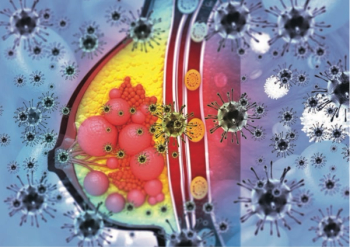
- Oncology Vol 29 No 4_Suppl_1
- Volume 29
- Issue 4_Suppl_1
(S035) Cervical Cancer Outcome Prediction to High-Dose-Rate Brachytherapy Using Quantitative Magnetic Resonance Imaging Analysis of Tumor Response to External Beam Radiotherapy
Aside from the known benefits of IGBT, MRI-based planning allows for assessment of tumor regression and prognosticates patients, as shown in the present study. If these findings are replicated in prospective trials, alternative methods, such as dose escalation and surgical salvage, should be considered to offset poor prognoses.
Beant S. Gill, MD, David Minkoff, BA, Hayeon Kim, MS, DABR, Christopher Houser, MS, Sushil Beriwal, MD; Magee-Womens Hospital, University of Pittsburgh Medical Center
PURPOSE: Image-guided brachytherapy (IGBT) has been shown to improve outcomes for cervical cancer. Integration of magnetic resonance imaging (MRI) allows visualization of residual disease. In order to assess tumor regression and outcomes, a volumetric analysis was conducted among patients treated with MRI-based IGBT.
METHODS: Consecutive patients with International Federation of Gynecology and Obstetrics (FIGO) stage IB1–IVA cervical cancer receiving definitive chemoradiation from 2007–2013 were identified. Patients were excluded if they were undergoing perineal template-based interstitial brachytherapy or if MRI was not completed prior to therapy and at first brachytherapy application. All patients were treated using a ring and tandem with or without interstitial needles. High-dose-rate brachytherapy was delivered in five once- or twice-weekly fractions of 5–6 Gy/fraction. Optimization was completed to meet the following cumulative equivalent 2-Gy doses (EQD2): high-risk clinical target volume (HRCTV) 75–85 Gy and 2 cc of rectum ≤ 70 Gy, sigmoid ≤ 70 Gy, and bladder ≤ 85 Gy. T2-weighted imaging using 1.5-T MRI was completed following brachytherapy applicator insertion. Gross tumor volumes (GTVs) were retrospectively contoured and defined: GTV prior to therapy (GTVPre-EBRT), GTV at first application (GTVIGBT), and percentage residual GTV at first application (GTV%Residual).
RESULTS: Eighty-four patients were identified. The majority had FIGO stage IIB disease (57.1%) and squamous histology (82.1%) and received median external beam and brachytherapy doses of 45.0 Gy and 27.5 Gy, respectively. With a 20.8-month (range: 3–74 mo) median follow-up, the 2-year Kaplan-Meier estimates of local control (LC), disease-free survival (DFS), and overall survival (OS) were 91.3%, 79.8%, and 85.0%, respectively. Median GTVPre-EBRT, GTVIGBT, and GTV%Residual values were 31.9 cc (range: 2.6–171.3 cc), 3.5 cc (range: 0.0–36.6 cc), and 9.7% (range: 0.0%–67.3%). Multivariate Cox regression revealed adenocarcinoma (hazard ratio [HR] = 5.76; P = .03) and GTVIGBT (HR = 1.17; P < .01) as predictors for local failure. Additionally, GTVIGBT was associated with any disease recurrence (HR = 1.17; P < .01) and overall mortality (HR = 1.20; P < .01). GTVIGBT > 7.5 cc was associated with inferior 2-year LC (75.0% vs 96.6%; P < .01), DFS (42.6% vs 91.6%; P < .01), and OS (65.2% vs 91.5%; P < .01). No difference in mean HRCTV D90 EQD2 was seen between these groups (83.2±2.2 Gy vs 83.5±2.7 Gy; P = .61).
CONCLUSION: Aside from the known benefits of IGBT, MRI-based planning allows for assessment of tumor regression and prognosticates patients, as shown in the present study. If these findings are replicated in prospective trials, alternative methods, such as dose escalation and surgical salvage, should be considered to offset poor prognoses.
Proceedings of the 97th Annual Meeting of the American Radium Society-
Articles in this issue
Newsletter
Stay up to date on recent advances in the multidisciplinary approach to cancer.

















































































